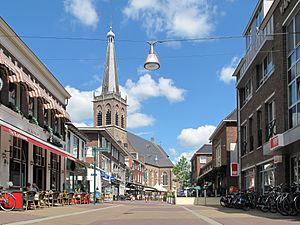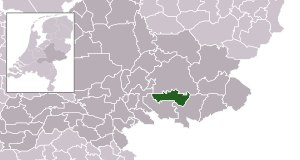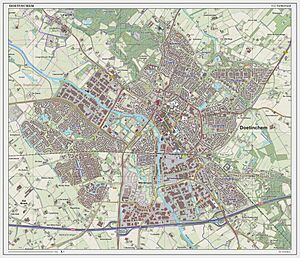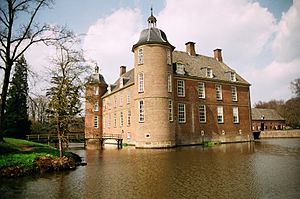Doetinchem facts for kids
Quick facts for kids
Doetinchem
Deutekem (Achterhoeks)
|
|||
|---|---|---|---|

Church in Doetinchem
|
|||
|
|||

Location in Gelderland
|
|||
| Country | Netherlands | ||
| Province | Gelderland | ||
| Government | |||
| • Body | Municipal council | ||
| Area | |||
| • Total | 79.66 km2 (30.76 sq mi) | ||
| • Land | 79.06 km2 (30.53 sq mi) | ||
| • Water | 0.60 km2 (0.23 sq mi) | ||
| Elevation | 14 m (46 ft) | ||
| Population
(May 2014)
|
|||
| • Total | 56,436 | ||
| • Density | 714/km2 (1,850/sq mi) | ||
| Demonym(s) | Doetinchemmer | ||
| Time zone | UTC+1 (CET) | ||
| • Summer (DST) | UTC+2 (CEST) | ||
| Postcode |
7000–7011, 7030–7031
|
||
| Area code | 0314, 0315 | ||
Doetinchem (pronounced like DOO-ting-khem) is a cool city and a municipality (which is like a local government area) in the eastern part of the Netherlands. It's located along the Oude IJssel (Old IJssel) river. This area is part of the province of Gelderland and is known as the Achterhoek.
Doetinchem is the biggest town in the Achterhoek region. In 2005, the nearby municipality of Wehl and the Zelhelmse Broek area joined with Doetinchem, making it even larger.
Contents
Doetinchem's Neighborhoods and Towns
The municipality of Doetinchem is made up of different parts. These include the main city of Doetinchem itself, plus several neighborhoods and smaller towns.
City and Neighborhoods
- Doetinchem (the main city)
- Centrum (the city center)
- Bezelhorst
- Dichteren
- Overstegen
- De Huet
- De Hoop
- Oosseld
- Schöneveld & Muziekbuurt
Smaller Towns and Villages
- Gaanderen
- Wehl (which used to be its own municipality)
- IJzevoorde
- Langerak
- Wijnbergen (Doetinchem)
- Nieuw-Wehl
A Look Back: Doetinchem's History
People have lived in the Doetinchem area for a very long time! We know this from old things found there, like skulls, pottery, and flint arrowheads. These items show that hunters lived here over 11,000 years ago. Later, different tribes like the Celts and Germanic people settled here. Even Roman coins have been discovered, and there's proof that Vikings visited and took things from the area.
Early Mentions and Growth
The name Doetinchem first appeared in a document from the year 838. It mentioned a 'villa Duetinghem', which was a small settlement with a church. In 887, it was called 'Deutinkem', a fortress with a church given to the Bishop of Utrecht. The spelling of the name changed many times over the centuries.
For a long time, Doetinchem stayed small. But around the year 1100, it began to grow. After facing many attacks from people trying to steal things, a town wall was built to protect it.
Becoming a City
In 1236, Doetinchem was given "city rights" by Count Otto II of Gelre and Zutphen. This meant the town could govern itself more. In return, the city had to pay taxes and provide soldiers for the Count's army. The new city council also created rules for the city, which were written down in the 'Keurboek van Doetinchem'.
City Defenses and Markets
To protect itself even more, the city wall was made taller in 1226. The wall had four weak spots, which were later replaced by strong city gates. These gates were called the Hamburgerpoort, the Waterpoort, the Gruitpoort, and the Hezenpoort. A moat (a ditch filled with water) was also dug around the wall, and a rampart (a protective mound of earth) was built in front of it. One of the city's windmills, the 'walmolen', still stands on what's left of this rampart.
Even with these defenses, Doetinchem was attacked many times. During the Eighty Years' War (1568–1648), it was captured twice. Eventually, the walls were seen as not needed anymore, or perhaps not very helpful, and they were torn down in 1672. The city gates and most of the rampart were removed later, in the 1800s.
From its early days, Doetinchem was an important place for farmers to sell their goods. The market was held in the central square called the Simonsplein until World War II.
Challenges and Rebuilding
Doetinchem has faced many tough times. In 1527, a big fire destroyed most of the city, including its old records. This means some early dates in Doetinchem's history are not perfectly clear. In 1580, a terrible plague killed many people. There were also floods sometimes.
During the First World War, the Netherlands stayed neutral, so Doetinchem was mostly unaffected. In the Second World War, Doetinchem also had a relatively easy start. However, in March and April 1945, the city center was heavily damaged by Allied bombing. The city was freed by Canadian soldiers in 1945 after a short fight.
After the war, Doetinchem grew quickly. It became bigger than other nearby towns like Doesburg and Zutphen. New areas were built, and villages like Wehl joined the municipality. Doetinchem continues to grow today, with new districts, a modern theater, and a cinema.
Important Buildings in Doetinchem
Doetinchem has several interesting buildings and structures.
Churches and Castles
The main church in the central square is called St Catherine's Church ('Catharinakerk'). It was almost completely destroyed during World War II but was rebuilt between 1948 and 1963. While it was originally a Catholic church, it became Dutch Reformed in 1591. There are also two castles nearby: 'De Kelder' ('The Cellar') and Slangenburg Castle.
Windmills
The city has three windmills.
- The De Walmolen is in the city center. The bottom part of this mill now holds the city's tourist office.
- In the Dichteren area, there's a mill called Aurora (which means 'dawn' in Latin).
- To the east of the city, you can find the Benninkmolen.
All these windmills are usually open for visitors on one weekday morning and at other times by appointment.
Other Key Buildings
Other important buildings include the Amphion-Theater, which is a modern theater, and the Gruitpoort, a large cultural center. The Rietveld Lyceum is the biggest high school in Doetinchem.
Sports in Doetinchem
Doetinchem is home to a professional football (soccer) team called De Graafschap ('The County'). Their home stadium was completely updated to be an all-seater arena with covered stands. The roof is painted in the club's blue and white colors.
The city also has an indoor swimming pool called Rozengaarde. Every year in April or May, a local evening four-day marathon is organized. Since 2005, a four-day marathon that starts and ends in Doetinchem runs through the Achterhoek region. In 2009, the city's volleyball team played in the CEV cup against a team from Turkey.
Fun Festivals
Doetinchem hosts some exciting annual festivals.
- The Buitengewoon (Extraordinary) festival is a street-theatre festival.
- The City Festival is a big event with music, theater, a carnival, and fireworks.
Famous People from Doetinchem
Many notable people have come from Doetinchem.
Historical Figures
- Frederik Johan van Baer, Lord of Slangenburg (1645–1713) was a Dutch military officer.
- Carel Hendrik Ver Huell (born 1764) was a Dutch and later French admiral and statesman.
Modern Personalities
- Geert Dales (born 1952) is a Dutch politician.
- Jan Rietman (born 1952) is a pianist and presenter on radio and TV.
- Maria Martens (born 1955) was a politician and a Member of the European Parliament.
- Thomas Rosenboom (born 1956) is a Dutch author.
- Henriette de Swart (born 1961) is a Dutch linguist and academic.
- John Hondorp (born 1964) is a jazz organist and teaches the Hammond organ.
- Wilke te Brummelstroete (born around 1975) is a Dutch mezzo-soprano singer.
- Rianne Letschert (born 1976) is a Dutch law scholar and Rector of Maastricht University.
- Janouk Kelderman (born 1991) is a Dutch actor, singer, and television presenter.
Sports Stars
- Desi Reijers (born 1964) is a freestyle swimmer who competed in the 1984 Summer Olympics.
- Paul Bosvelt (born 1970) is a former professional football player.
- Chris Bruil (born 1970) is a badminton player who competed in the 2004 Summer Olympics.
- Rogier Meijer (born 1981) is a former Dutch footballer.
- Glenn Loovens (born 1983) is a Dutch professional footballer.
- Sanne Keizer (born 1985) is a Dutch beach volleyball player.
- Marloes Wesselink (born 1987) is a Dutch professional beach volleyball player.
- Siem de Jong (born 1989) is a Dutch professional footballer.
- Luuk de Jong (born 1990) is a Dutch professional footballer.
- Jelle van Gorkom (born 1991) is a Dutch BMX racing cyclist who won a silver medal at the 2016 Summer Olympics.
- Richèl Hogenkamp (born 1992) is a Dutch professional tennis player.
- Siri Worm (born 1992) is a Dutch women's football defender.
- Alexander Büttner (born 1989) is a Dutch professional footballer who plays for De Graafschap.
Local News and Media
Doetinchem has its own local media. Newspapers available include "De Gelderlander" and free papers like "Doetinchems Vizier" and "Zondag". The city also has its own television station called 'Stadstv'. Another station, 'GraafschapTV', can be watched throughout the entire Achterhoek region.
Getting Around: Transport
Doetinchem is well-connected to the rest of the Netherlands.
Roads
The city has been part of the Dutch national highway system since 1974. What was once Highway 15 is now called the A18.
Trains
Doetinchem has train services to Arnhem and Winterswijk. There are two train stations: Doetinchem in the city center and Doetinchem De Huet in the west. You can catch trains to Arnhem four times an hour on weekdays.
Buses
Bus services in Doetinchem are also available, making it easy to travel around the city and nearby areas.
Images for kids
-
Doetinchem, street art: de D-toren
See also
 In Spanish: Doetinchem para niños
In Spanish: Doetinchem para niños











